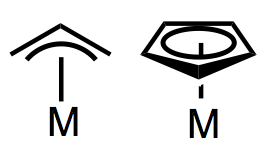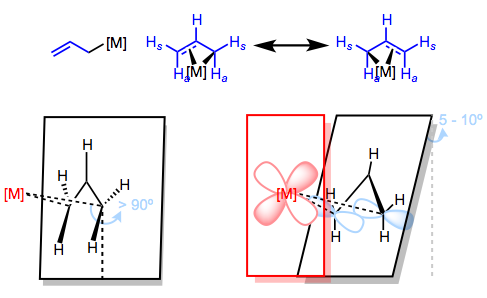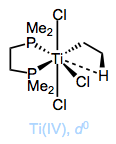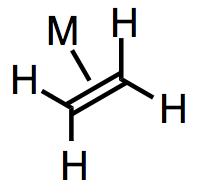Posts Tagged ‘migratory insertion’
Migratory Insertion: 1,2-Insertions
Insertions of π systems into M-X bonds are appealing in the sense that they establish two new σ bonds in one step, in a stereocontrolled manner. As we saw in the last post, however, we should take care to distinguish these fully intramolecular migratory insertions from intermolecular attack of a nucleophile or electrophile on a coordinated π-system ligand. The reverse reaction of migratory insertion, β-elimination, is not the same as the reverse of nucleophilic or electrophilic attack on a coordinated π system.
Like 1,1-insertions, 1,2-insertions generate a vacant site on the metal, which is usually filled by external ligand. For unsymmetrical alkenes, it’s important to think about site selectivity: which atom of the alkene will end up bound to metal, and which to the other ligand? To make predictions about site selectivity we can appeal to the classic picture of the M–X bond as M+X–. Asymmetric, polarized π ligands contain one atom with excess partial charge; this atom hooks up with the complementary atom in the M–R bond during insertion. Resonance is our best friend here!
A nice study by Yu and Spencer illustrates these effects in homogeneous palladium- and rhodium-catalyzed hydrogenation reactions. Unactivated alkenes generally exhibit lower site selectivity than activated ones, although steric differences between the two ends of the double bond can promote selectivity. Read the rest of this entry »
Migratory Insertion: Introduction & CO Insertions
We’ve seen that the metal-ligand bond is generally polarized toward the ligand, making it nucleophilic. When a nucleophilic, X-type ligand is positioned cis to an unsaturated ligand in an organometallic complex, an interesting process that looks a bit like nucleophilic addition can occur.
On the whole, the unsaturated ligand appears to insert itself into the M–X bond; hence, the process is called migratory insertion. An open coordination site shows up in the complex, and is typically filled by an added ligand. The open site may appear where the unsaturated ligand was or where the X-type ligand was, depending on which group actually moved (see below). There is no change in oxidation state at the metal (unless the ligand is an alkylidene/alkylidyne), but the total electron count of the complex decreases by two during the actual insertion event—notice in the above example that the complex goes from 18 to 16 total electrons after insertion. A dative ligand comes in to fill that empty coordination site, but stay flexible here: L could be a totally different ligand or a Lewis base in the X-type ligand. L can even be the carbonyl oxygen itself!
We can distinguish between two types of insertions, which differ in the number of atoms in the unsaturated ligand involved in the step. Insertions of CO, carbenes, and other η1 unsaturated ligands are called 1,1-insertions because the X-type ligand moves from its current location on the metal to one spot over, on the atom bound to the metal. η2 ligands like alkenes and alkynes can also participate in migratory insertion; these reactions are called 1,2-insertions because the X-type ligand slides two atoms over, from the metal to the distal atom of the unsaturated ligand.

1,2-insertion of an alkene and hydride. In some cases, an agostic interaction has been observed in the unsaturated intermediate.
This is really starting to look like the addition of M and X across a π bond! However, we should take care to distinguish this completely intramolecular process from the attack of a nucleophile or electrophile on a coordinated π system, which is a different beast altogether. Confusingly, chemists often jumble up all of these processes using words like “hydrometalation,” “carbometalation,” “aminometalation,” etc. Another case of big words being used to obscure ignorance! We’ll look at nucleophilic and electrophilic attack on coordinated ligands in separate posts.








